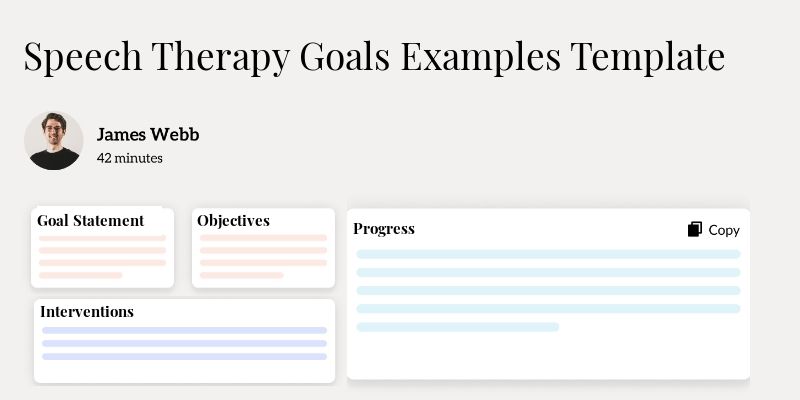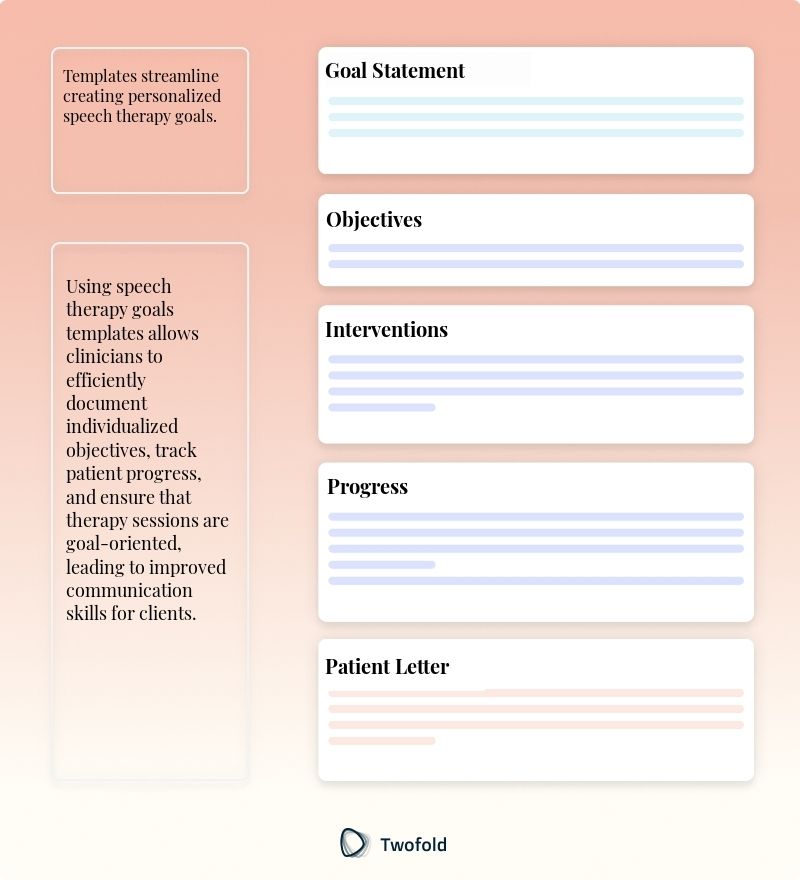
Speech Therapy Goals Examples Template
Imagine trying to craft the perfect set of speech therapy goals without a trusty guide. It can feel akin to navigating uncharted waters, leading many therapists to seek out reliable note templates for support. If you've ever found yourself wondering how to streamline this process and make your notes truly reflect the essence of each session, this blog post is for you!
What Is a Speech Therapy Goals Template?
The Speech Therapy Goals Template is a structured tool that helps therapists design, document, and track individualized goals for their patients. It serves as a guide that simplifies the process of creating effective therapy plans.
This template streamlines communication with other stakeholders such as parents and educators, by providing a consistent format that outlines objectives and progress. It's an essential resource in ensuring that therapy sessions remain focused and effective.
Key Components of a Speech Therapy Goals Template
Understanding the critical elements of this template is essential for effective application:
- Patient Information: Details specific to the individual, including age, diagnosis, and background.
- Goal Statements: Clearly defined therapy goals that are specific, measurable, achievable, relevant, and time-bound (SMART).
- Session Objectives: Short-term objectives that build towards achieving the overarching goals.
- Progress Tracking: Methods and metrics for tracking and documenting the patient's progress over time.
- Intervention Strategies: Customized strategies tailored to address the unique needs of the patient.
- Review Schedule: Planned intervals for evaluating and adjusting goals as necessary.

How to Use a Speech Therapy Goals Template: Step-by-Step Process
Step 1: Gather Patient Information
Start by collecting all relevant background information about the patient, including their personal details and any medical diagnoses.
Step 2: Define Goals
Create clear and measurable goals that address the specific speech therapy needs of the patient.
Step 3: Set Objectives
Break down each goal into smaller, actionable objectives to guide each session.
Step 4: Develop Strategies
Identify and document effective approaches and techniques to be used during therapy sessions.
Step 5: Track Progress
Use the template to record observations and track the patient's progress consistently after each session.
Step 6: Review and Adjust Goals
Schedule regular reviews to assess progress and modify goals as necessary.
Benefits of a Speech Therapy Goals Template
Benefit | Detail |
|---|---|
Consistency | Ensures that all goals and progress reports follow a standard format, making them easy to understand and share. |
Focus | Helps maintain focus during sessions by keeping goals visible and specific. |
Communication | Facilitates clear communication between therapists, patients, and other stakeholders. |
Accountability | Provides a record of progress, which is useful for accountability and justification of therapy methods. |
Stakeholders in Speech Therapy Goals Template
The following stakeholders play significant roles in the speech therapy process:
- Therapists: Lauren, a speech therapist, uses these templates to craft tailored strategies for each of her clients.
- Patients: Tom, a young patient, benefits from clearly outlined goals which motivate his participation in sessions.
- Families: Emily's parents review the progress notes and actively participate in her therapy plan outlined in the template.
- Educators: Ms. Baker, an SLP in a school, uses these templates to support IEP meetings and convey strategies to classroom teachers.
Example of a Speech Therapy Goals Template PDF
For those who prefer visual guides, downloadable PDF examples offer clarity and detail, showcasing the practical application of these templates.
Real-World Use Cases: Practical Impact of the Speech Therapy Goals Template
This template's impact extends across various real‑world applications:
- In a bustling school setting, Jane ensures her students' language needs are met by employing a robust template during her therapy planning sessions.
- At a busy private practice, Dr. Smith seamlessly integrates these templates to enhance collaborative care with multidisciplinary teams.
- An SLP in a rehabilitation center, Karen provides improved patient care, supported by clearly documented progress and goal charts.
- In teletherapy, Alex, a virtual speech therapist, effectively uses the template to facilitate goal-setting over long-distance sessions.
Conclusion
The Speech Therapy Goals Template stands as a fundamental tool for therapists, enabling structured and effective goal setting. This approach not only ensures consistency and clarity but also significantly enhances communication among stakeholders. With examples and setup processes outlined in detail, therapists are empowered to create impactful and personalized therapy plans.
Disclaimer: This article is for informational purposes only and does not constitute legal or medical advice. Always consult professional guidelines and regulatory bodies for specific compliance requirements.

Dr. Danni Steimberg
Dr. Danni Steimberg is a pediatrician at Schneider Children’s Medical Center with extensive experience in patient care, medical education, and healthcare innovation. He earned his MD from Semmelweis University and has worked at Kaplan Medical Center and Sheba Medical Center.
Great speech goals are functional, measurable, and easy to advance. The ACE‑3C builder ‑ Action, Context, Evidence + Cueing, Criteria, Carryover ‑ turns examples into goals you can track and defend.
- Action, Context, Evidence: Start with a clear verb and target, set the context, and name how you will measure it. Example: "Produce /s/ in initial position at phrase level in 20 trials with data captured per trial."
- Cueing and Criteria: Specify support and mastery. Example: "With minimal verbal cues, reach 80% accuracy across 2 consecutive sessions by week 6."
- Carryover: Add a generalization step so success moves beyond the clinic. Example: "After mastery in structured tasks, demonstrate 70% accuracy in spontaneous conversation at home or classroom with caregiver tally for one week."
Frequently Asked Questions
Reduce burnout,
improve patient care.
Join thousands of clinicians already using AI to become more efficient.

Psychotherapy Progress Note Template
Discover practical Psychotherapy Progress Note Templates to enhance your documentation efficiency.

SOAP Note Template
Discover practical SOAP Note templates to enhance your documentation efficiency.

Living Well Template
Discover practical Living Well templates to enhance your documentation efficiency.

